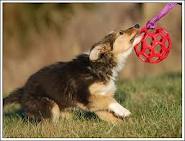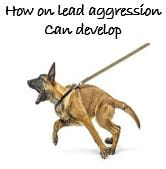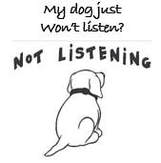.

One of the biggest myths I hear is that clicker training isn't good for stopping problem behaviors. Part of that myth stems from the belief that because clicker trainers don't use positive punishment, there are no consequences for undesired behavior. Of course there are! We just don't have to use fear, pain, or intimidation.
Ignoring undesired behavior
Ignoring undesired behavior is a technique called extinction. Extinction is an operant conditioning principle that states that if a behavior is not reinforced, it will gradually eliminate. It is the loss of an opportunity for a reward.
For example, the trainer asks for a sit. The dog offers a down. Instead of correcting the dog, the trainer waits five seconds, then asks again. If the dog sits, the trainer reinforces it. Because the down wasn't reinforced, it is less likely that the dog will off it when "sit" is cued.
In another example, the same technique can be used to teach an alternative behavior. A dog barks at passers-by. The trainer waits for the dog to stop barking, then reinforces the silence. To speed up the process, the trainer sets up a scenario where a person will pass the house several times. He reinforces the dog heavily in the moments of silence, ignoring the barking. The dog gradually learns that it is more reinforcing to be quiet, so the barking extinguishes.
Negative punishment
In addition to extinction, clicker trainers use negative punishment. Negative punishment is the removal of something in order to decrease the frequency of a behavior. Examples include removing attention, giving a dog a "time out," and feeding a treat to another dog (or eating it yourself). When clicker trainers want to suppress an undesired behavior, they rely more heavily on negative punishment than positive punishment because negative punishment is equally effective and causes neither fear nor pain.
Although clicker trainers try to rely most heavily on positive reinforcement, the idea that they use it exclusively is completely false.
Changing undesired behavior
The first step in changing undesired behavior is to identify the behaviors that you want to change. Every time you interact with your dog, ask yourself, "Is my dog doing something I want him to do?"
The second step is to define what you want your dog to do. If your dog is doing something you don't like, define what you want him to do instead. It's not enough to say "I want him to stop doing what he's doing." He could stop doing what he's doing and choose to do something worse - and then you'd have to stop that as well. It's faster to define what you want him to do from the beginning. For example:
For example, a dog jumps on someone as a greeting, even if the person yells and pushes him away. Why? Because the dog wants attention. If he doesn't jump, he was likely ignored. So he jumps, even if he is yelled at for it. Until you can teach your dog that jumping isn't reinforcing but sitting politely is, manage the situation by putting him in another room when the doorbell rings.
The final step is to train a preferred behavior. If you make the new behavior reinforcing and simultaneously make the old behavior unrewarding, the dog will quickly choose to do the new behavior.
Melissa Alexander
copyright 2000 Melissa Alexander
Ignoring undesired behavior
Ignoring undesired behavior is a technique called extinction. Extinction is an operant conditioning principle that states that if a behavior is not reinforced, it will gradually eliminate. It is the loss of an opportunity for a reward.
For example, the trainer asks for a sit. The dog offers a down. Instead of correcting the dog, the trainer waits five seconds, then asks again. If the dog sits, the trainer reinforces it. Because the down wasn't reinforced, it is less likely that the dog will off it when "sit" is cued.
In another example, the same technique can be used to teach an alternative behavior. A dog barks at passers-by. The trainer waits for the dog to stop barking, then reinforces the silence. To speed up the process, the trainer sets up a scenario where a person will pass the house several times. He reinforces the dog heavily in the moments of silence, ignoring the barking. The dog gradually learns that it is more reinforcing to be quiet, so the barking extinguishes.
Negative punishment
In addition to extinction, clicker trainers use negative punishment. Negative punishment is the removal of something in order to decrease the frequency of a behavior. Examples include removing attention, giving a dog a "time out," and feeding a treat to another dog (or eating it yourself). When clicker trainers want to suppress an undesired behavior, they rely more heavily on negative punishment than positive punishment because negative punishment is equally effective and causes neither fear nor pain.
Although clicker trainers try to rely most heavily on positive reinforcement, the idea that they use it exclusively is completely false.
Changing undesired behavior
The first step in changing undesired behavior is to identify the behaviors that you want to change. Every time you interact with your dog, ask yourself, "Is my dog doing something I want him to do?"
The second step is to define what you want your dog to do. If your dog is doing something you don't like, define what you want him to do instead. It's not enough to say "I want him to stop doing what he's doing." He could stop doing what he's doing and choose to do something worse - and then you'd have to stop that as well. It's faster to define what you want him to do from the beginning. For example:
- I want my dog to hold a sit-stay while I prepare his food. (Not "I want my dog to stop jumping on me when I prepare his food.")
- I want my dog to sit at the top or bottom of the stairs when a person is walking up or down.
- I want my dog to lie quietly on a mat while the family eats dinner.
- I want my dog to lie quietly on a mat when I have visitors.
For example, a dog jumps on someone as a greeting, even if the person yells and pushes him away. Why? Because the dog wants attention. If he doesn't jump, he was likely ignored. So he jumps, even if he is yelled at for it. Until you can teach your dog that jumping isn't reinforcing but sitting politely is, manage the situation by putting him in another room when the doorbell rings.
The final step is to train a preferred behavior. If you make the new behavior reinforcing and simultaneously make the old behavior unrewarding, the dog will quickly choose to do the new behavior.
Melissa Alexander
copyright 2000 Melissa Alexander
|
Handling on lead aggression
Some tips from a professional on what to do if your dog is starting this behaviour |
Hard to Train
Some dogs and some breeds are just harder to train than others. Some tips for making it easier with a dog like this. |
My dog just wont listen!
Ha, sound familiar?? Here is why this can happen and what to do about it. |




